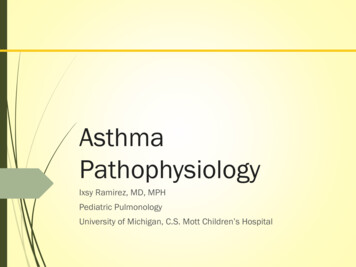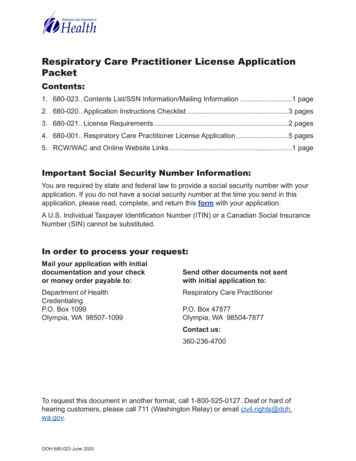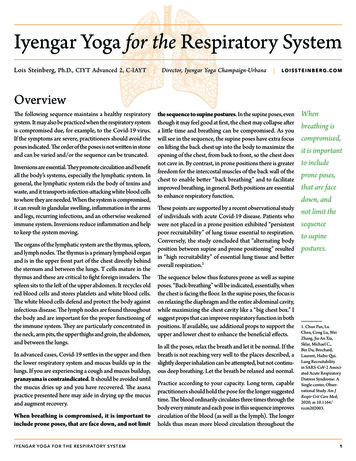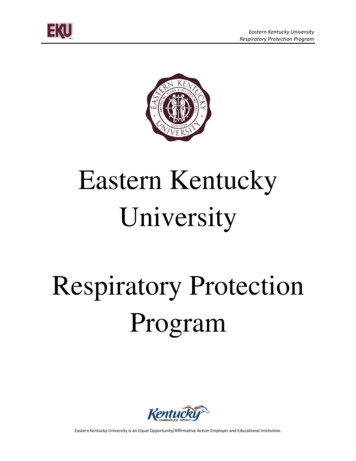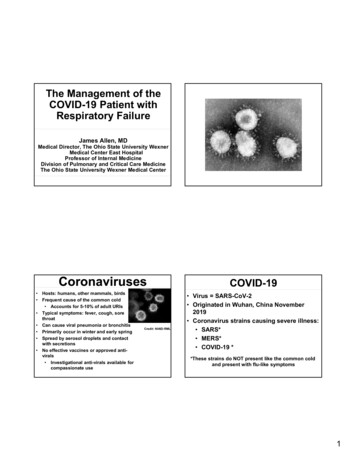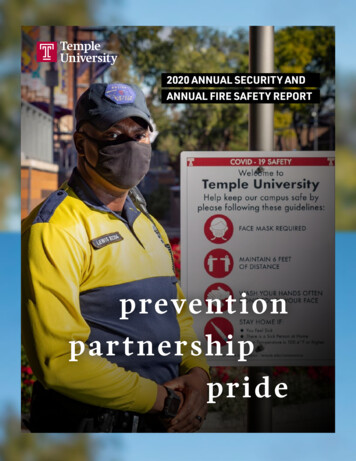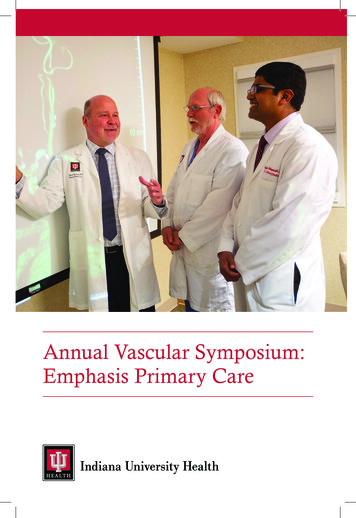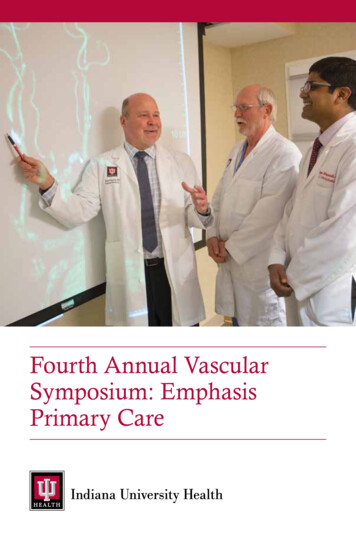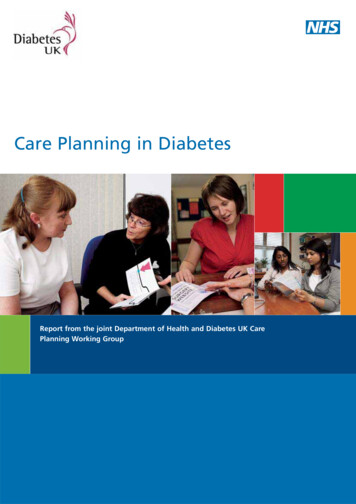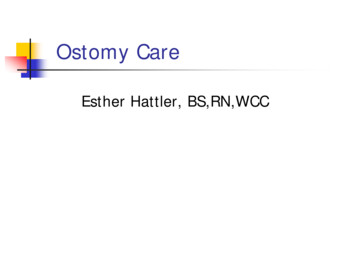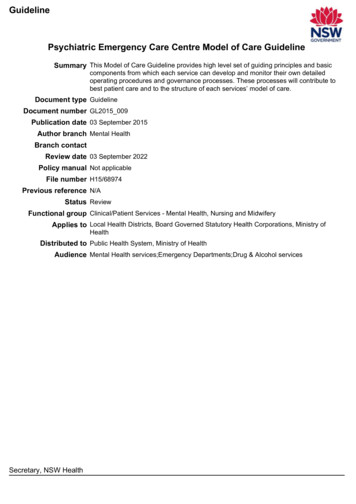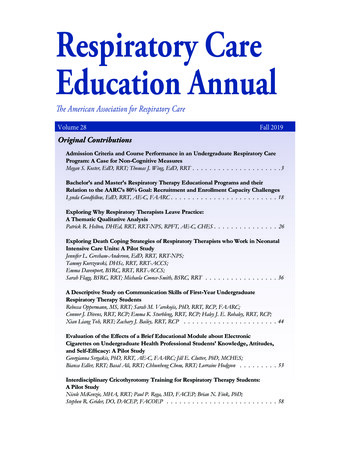
Transcription
Respiratory CareEducation AnnualThe American Association for Respiratory CareVolume 28Fall 2019Original ContributionsAdmission Criteria and Course Performance in an Undergraduate Respiratory CareProgram: A Case for Non-Cognitive MeasuresMegan S. Koster, EdD, RRT; Thomas J. Wing, EdD, RRT . . . . . . . . . . . . . . . . . . . . . 3Bachelor’s and Master’s Respiratory Therapy Educational Programs and theirRelation to the AARC’s 80% Goal: Recruitment and Enrollment Capacity ChallengesLynda Goodfellow, EdD, RRT, AE-C, FAARC . . . . . . . . . . . . . . . . . . . . . . . . . 18Exploring Why Respiratory Therapists Leave Practice:A Thematic Qualitative AnalysisPatrick R. Helton, DHEd, RRT, RRT-NPS, RPFT, AE-C, CHES . . . . . . . . . . . . . . . 26Exploring Death Coping Strategies of Respiratory Therapists who Work in NeonatalIntensive Care Units: A Pilot StudyJennifer L. Gresham-Anderson, EdD, RRT, RRT-NPS;Tammy Kurszewski, DHSc, RRT, RRT-ACCS;Emma Davenport, BSRC, RRT, RRT-ACCS;Sarah Flagg, BSRC, RRT; Michaela Coonce-Smith, BSRC, RRT . . . . . . . . . . . . . . . . . 36A Descriptive Study on Communication Skills of First-Year UndergraduateRespiratory Therapy StudentsRebecca Oppermann, MS, RRT; Sarah M. Varekojis, PhD, RRT, RCP, FAARC;Connor J. Divens, RRT, RCP; Emma K. Sturbleng, RRT, RCP; Haley J. E. Rohaley, RRT, RCP;Xian Liang Toh, RRT; Zachary J. Bailey, RRT, RCP . . . . . . . . . . . . . . . . . . . . . . 44Evaluation of the Effects of a Brief Educational Module about ElectronicCigarettes on Undergraduate Health Professional Students’ Knowledge, Attitudes,and Self-Efficacy: A Pilot StudyGeorgianna Sergakis, PhD, RRT, AE-C, FAARC; Jill E. Clutter, PhD, MCHES;Bianca Edler, RRT; Basal Ali, RRT; Chhunheng Chom, RRT; Lorraine Hodgson . . . . . . . . . 53Interdisciplinary Cricothyrotomy Training for Respiratory Therapy Students:A Pilot StudyNicole McKenzie, MHA, RRT; Paul P. Rega, MD, FACEP; Brian N. Fink, PhD;Stephen R. Grider, DO, DACEP, FACOEP . . . . . . . . . . . . . . . . . . . . . . . . . . 58
Respiratory CareEducation AnnualThe American Association for Respiratory CareEDITORIAL OFFICE9425 N MacArthur BlvdSuite 100Irving, TX 75063-4706(972) 514-7710Fax (972) 484-2720www.aarc.orgMANAGING EDITORShawna L. Strickland, PhD,RRT, AE-C, FAARCAssociate Executive DirectorAmerican Association forRespiratory Careshawna.strickland@aarc.orgPUBLISHERThomas J. Kallstrom, MBA,RRT, FAARCExecutive Director/Chief Executive OfficerAmerican Association forRespiratory Carekallstrom@aarc.orgEDITORKathy S. Myers Moss, PhD, RRT, RRT-ACCS, FAARCChair and Clinical ProfessorDepartment of Clinical and Diagnostic SciencesUniversity of MissouriMossK@health.missouri.eduASSOCIATE EDITORDennis R. Wissing, PhD, RRT, AE-C, FAARCDeanCollege of Education and Human DevelopmentLSU Shreveportdennis.wissing@lsus.eduEDITORIAL BOARDWill Beachey, PhD, RRT, FAARCProfessor EmeritusSchool of Health SciencesUniversity of Marywdbeachey@gmail.comDave Burnett, PhD, RRT, AE-CAssociate Dean for Faculty and CommunityPartnershipsSchool of Health ProfessionsChair and Assistant ProfessorDepartment of Respiratory Care and DiagnosticScienceUniversity of Kansas Medical Centerdburnett@kumc.eduGregg Marshall, PhD, RRT, RPSGT, RST, RCPChair and ProfessorDepartment of Respiratory Care & Texas State SleepCenterTexas State University — Round Rock Campussm10@txstate.eduMary Martinasek, PhD, CPH, MCHES, RRTAssociate ProfessorHealth Sciences and Human Performance DepartmentUniversity of TampaMMartinasek@UT.eduConstance Mussa, PhD, RRT, RRT-NPSccmussa@gmail.comDavid W. Chang, EdD, RRTProfessorDepartment of Cardiorespiratory CareUniversity of South Alabamadchang@southalabama.eduKathy J. Rye, EdD, RRT, RRT-ACCS, FAARCProfessor EmeritusCollege of Health ProfessionsUniversity of Arkansas for Medical Sciencesryekathyj@uams.eduDouglas S. Gardenhire, EdD, RRT, RRT-NPS, FAARCChair and Clinical Associate ProfessorLewis College of Nursing and Health ProfessionsGeorgia State Universitydgardenhire@gsu.eduSarah Varekojis, PhD, RRT, FAARCAssociate ProfessorSchool of Health and Rehabilitation SciencesThe Ohio State UniversityVarekojis.16@osu.eduLutana Haan, MHS, RRT, RPSGTChair and Associate ProfessorDepartment of Respiratory CareBoise State Universitylutanahaan@boisestate.eduRespiratory Care Education Annual (ISSN 2372-0735) is a publication of the American Association for Respiratory Care, 9425 N. MacArthur Blvd., Ste. 100, Irving,TX 75063-4706. Copyright 2019 by the American Association for Respiratory Care. All rights reserved. Respiratory Care Education Annual is a refereed journalcommitted to the dissemination of research and theory in respiratory care education. The editors seek reports of research, philosophical analyses, theoreticalformulations, interpretive reviews of the literature, and point-of-view essays. The title page should contain (a) the title of the manuscript; (b) full names, institutionalaffiliations, and positions of the authors; and (c) acknowledgments of formal contributions to the work by others, including support of the research, if any. The firstpage of the article should repeat the title of the article and include an abstract of no more than 250 words. The name(s) of the author(s) should not appear on this orany subsequent page of the text. For rules governing references and style, consult Guidelines for Authors. Manuscripts that do not conform to these standards will bereturned for revision. Send all submissions and editorial correspondence to edu@aarc.org. Manuscripts must be submitted electronically.
Respiratory Care Education AnnualVolume 27, Fall 2019, 3 –17Admission Criteria and Course Performance in an UndergraduateRespiratory Care Program: A Case for Non-Cognitive MeasuresMegan S. Koster, EdD, RRTThomas J. Wing, EdD, RRTAbstractIntroduction: Admission processes for health care programs traditionally focus on a student’s cognitive ability. This unilateral approach to the evaluation of intelligence representsan incomplete understanding of a student’s ability in a clinically-based program, such asRespiratory Care. Research has indicated non-cognitive characteristics are vitally importantto the future success of working health care providers. The purpose of this research was toassess the relationships among admission criteria categorized according to Sternberg’s Triarchic Theory and performance in a baccalaureate Respiratory Care program. Methods: Inaddition to cognitively-focused admission criteria, students applying to an undergraduateRespiratory Care program participated in a multiple mini-interview (MMI) to demonstratenon-cognitive skills described as essential to health care practitioners. Students were rankedby performance and selected for admission. Relationships among criteria classified according to Sternberg’s Triarchic Theory and performance in foundational Respiratory Carecourses were explored for significance. Results: Significant relationships among indicatorsof either componential, experiential, or contextual intellect and course performance weresporadic. However, significant correlations existed between MMI scores and performancein clinical practicum. Conclusions: Health care workers are required to demonstrate notonly cognitive aptitude, but also the ability to apply new concepts in new contexts. However, most traditional admission practices overlook the value of non-cognitive ability. Clinically-focused undergraduate programming may benefit from incorporating non-cognitivemeasures into admission practices. The adoption of a revised MMI, in addition to a reviewof academic performance, may help to highlight contextual abilities inherent to the clinicalenvironment that are often overlooked by traditional admission practices.Key Words: Multiple-Mini Interview, Undergraduate Admissions, Respiratory Care, Intelligence, Non-Cognitive, Triarchic Theory of IntelligenceMegan S. Koster, EdD, RRTBoise State UniversityBoise, IdahoCorrespondence:Megan S. Koster, EdD, RRT1910 University Drive.MS 1850Boise, ID 83725megankoster@boisestate.edu(208) 426-3319Thomas J. Wing, EdD, RRTBoise State UniversityBoise, Idaho3
Admission Criteria and Course Performance in an Undergraduate Respiratory Care ProgramIntroductionRespiratory Care (RC) students are required to demonstrate mastery of the field-specific knowledge inherent tothe scope of the profession, as well as non-cognitive skillsidentified as essential to health care practitioners.1-2 Asdescribed by Stanford Medicine, interpersonal, communication, critical, and analytical skills are all required tosucceed as a new practitioner in a clinical environmentthat is both demanding and evolving (https://med.stanford.edu/, Accessed February 3, 2019).While there seems to be some momentum toward understanding the value of such skill in the academic setting,little research has been done on how to best address theutility of baseline non-cognitive skill in undergraduatehealth programs such as respiratory care.1,3-4 Much ofthe available literature regarding the utility of non-cognitive ability relates to the graduate environment.3-9 Thislack of published evidence at the undergraduate level isconcerning, given that most health care-specific fields require an entry-to-practice degree at this level. This gap inunderstanding may be due, in part, to a general lack ofconsensus about how best to evaluate such qualities uponadmission as well as how well these skills are linked to performance in an entry-to-practice program.1 Participationin a Multiple Mini-Interview (MMI) was incorporated bythis particular undergraduate baccalaureate program toaddress the lack of consideration for non-cognitive abilities throughout the admissions process. Permission to usedata pertinent to this study was granted by the institution’s review board.The overarching purpose of this investigation was toexplore whether demonstration of non-cognitive ability,in this case performance on the MMI, was more significantly related to academic performance in the clinicalenvironment than were other, more traditional types ofadmissions criteria. All admission criteria were categorized under the intellectual domains described in Sternberg’s Triarchic Theory of Intelligence as either cognitive,experiential, or contextual.10Triarchic Theory of IntelligenceThe general understanding of “intelligence” is simplythe ability to both acquire and apply knowledge and skillin a way that may be quantified using objective measures.10-11 The Triarchic Theory of Intelligence, introducedby Robert Sternberg in 1984 argues that any study of thephenomenon of “intelligence” requires a much broaderscope of understanding as to what skills are valuable.10-11To best capture the range of valuable skills, the TriarchicTheory asserts that there are three specific types of intellect: componential, experiential, and contextual.10 Given4this assertion, Triarchic Theory posits that knowledgeis first acquired as a result of mental processes that helpshape understanding and meaning.10 As illustrated inFigure 1, once comprehension has been established, individuals must cope with novelty to adapt understandingto new contexts by selecting and shaping the informationto fit the environment.10-12 Within this process, types ofintellect should not be considered superior to another, butrather complimentary and dependent upon the degree ofinvestment the learner has with information.Figure 1. Sternberg’s Triarchic Theory of Intelligence11, 13Componential intellect, or the ability to recall information in a static context, is a foundational requirement oflearning new information and is often assessed throughobjective and summative measures.10,13 However, overreliance on such measures disregards the demonstrationof other facets of intelligence, such as the ability to applylearned knowledge in dynamic settings or to developnovel applications of knowledge in a new context.10,13-14These abilities, referred to by Sternberg as experientialand contextual intellect, respectively, are arguably equallyimportant indicators of student development.10, 13-14 Describing intelligence as a multifaceted, non-linear phenomenon provides the framework for this investigationinto a more holistic approach to student assessment in theadmission process.Multiple Mini-InterviewThe MMI is best described as a structured, time-limited, interval station assessment.3,8,12 This framework issuch that a candidate moves through a series of focusedstations with scenario-based questions and, in contrastto a traditional interview, interacts with only one interviewer.7,8,15 Performance on each station is scored usinga standardized measurement tool.7,8,15 This format showspotential in the evaluation of students applying to healthscience programs because the stations can be adapted
Admission Criteria and Course Performance in an Undergraduate Respiratory Care Programto assess and discriminate between non-cognitive traitsnecessary for successful clinical practice.8,16 The abilityof the MMI to better evaluate non-cognitive skill canlikely be attributed to this structure in that the evaluative focus shifts away from the testing operation to thecandidate’s response to the scenario. Measurement toolsare designed to assess how the student responds to station prompts rather than whether the response was either“right” or “wrong.”7,8,15This demonstration of adaptation(i.e., applying existing knowledge in a dynamic or new environment) is a more accurate reflection of both experiential and contextual intellect.4,10,12-13,15,17 The structure andimplementation of the MMI reveals reasonable reliabilityand may be used to predict not only academic success inhealth programming, but also on corresponding licensureexams.3,18MethodsTo explore the relationships between admission criteriaand course performance, correlational analyses were conducted to explore the significance of the relationships between admission criteria and academic performance for acohort of undergraduate RC students (Cohort C). Retrospective correlational analyses were also performed withtwo additional cohorts (A and B) to establish a baselineunderstanding of existing relationships among admissioncriteria and academic performance prior to the additionof the MMI. Important study methods will be addressedin two parts. First, the development and implementationof the MMI specific to Cohort C is described. Then themethods by which the admission variables were categorized and analyzed across the three cohorts is addressed(Tables 2 and 4).Development and Implementation of the MMIThis study was conducted within a small RespiratoryCare department, at a mid-sized metropolitan university.All students applying to the Cohort C admission cycle(N 35) were required to participate in the MMI as part ofthe new admissions process adopted by the department.Data from this study were analyzed to identify relationships among indicators of componential, experiential,contextual intellect, and performance in foundationalfirst-semester courses within the program.MMI StructureThe MMI station scenarios identified for use were selected to evaluate non-cognitive skills highlighted by industry leaders as lacking by students upon entry to thelabor market: critical thinking, interpersonal skills, ethical judgment, time management, and self-appraisal.19The MMI format, structure, and measurement tool were5derived from open source materials developed by the Michael G. DeGroote School of Medicine at McMaster University, available through the program website (https://mdprogram.mcmaster.ca, Accessed June 12, 2019), aswell as sample MMI scenarios developed by the University of Calgary Medical School, also available on the program’s webpage.20 Complete examples of measurementinstruments adapted for use in this study are included inAppendix A. Limited by both time and human resources,this program utilized three, eight-minute MMI stationsdesigned to address one or two non-cognitive skills perstation. This format allowed three applicants to cyclethrough the stations during one, half-hour time interval(Appendix B).Applicants were cycled through each of the three stations to interact with a sole interviewer responsible for administering a scenario. This time-limited interaction withone interviewer is unique to the MMI and was designedto reduce the potential for interviewer bias, an issue common among traditional interview practices.21Interviewer selection and preparationInterviewers were identified who were intimately familiar with the requirements of the academic program andthe respiratory therapy profession. The interviewers werebriefed on the objective of the MMI process and informedof the structure of the assessment. Interrater reliabilitywas addressed through pilot testing wherein individualinterviewers were asked to evaluate a video-based scenario, using the measurement tool adapted for this particular program. Subscale scores on the pilot scenario werevery similar for the three interviewers (15, 15, and 16) sono additional interviewer training was provided.12 Interviewers were barred from reviewing any admission material related to applicants prior to conducting the MMI tolimit the potential for interviewer bias.Adapted MMI stationsThe topic scenarios used in this study remained relatively unchanged from those used by the University ofCalgary with the exception of editing the details to describe the field of Respiratory Care rather than medicalschool (Appendix A). Each of the non-cognitive attributesassessed in this study were selected to address key competencies identified as essential to successful clinicians.1,16,19Measurement instrumentThe measurement tool developed by McMaster University was amended for this study to include a set of subscales specific to each station (Appendix A). In additionto assigning a performance score using the subscales, interviewers were asked to differentiate students who scoredsimilarly on the station using a ranking system. Candidate
Admission Criteria and Course Performance in an Undergraduate Respiratory Care Programperformance was ranked on a scale of 1-35, with 35 beingthe best candidate. Interviewers were instructed to takenotes during each interview and to review those noteswhen ranking students to differentiate subtle differencesbetween students who may have scored the same on themore objective subscale.12Analysis of Admission CriteriaAdmission criteria across all cohorts were classifiedinto three categories based on Sternberg’s Triarchic Theory: componential, experiential, and contextual. Componential variables were those variables indicative of theability to recall information in a static context (e.g., coursegrades) or acquire knowledge over a period of time.10 Experiential variables were deemed those variables representative of an applicant’s ability to gather and demonstrateunderstanding in dynamic environments.10 Finally, contextual variables were those evaluations considered indicative of an applicant’s ability to apply acquired knowledgeto new contexts.10 Total applicant score was a weightedcombination of total file score (componential and experiential variables), essay score (experiential variable), and inthe case of Cohort C, performance on the MMI (contextual variable). Table 1 illustrates the total point value andassigned weight of each set of variables.It is important to note that some differences exist inwhich variables were included in the total file score acrosseach of the three cohorts. Whether a student was a truefreshman was not considered in either Cohort A or B.However, it was determined that these students werebeing penalized under the point system, due to the inability to accrue points through additional course work.To address this, true freshmen applying for admission toCohort C were awarded up to 4 points. It was also deter-
formulations, interpretive reviews of the literature, and point-of-view essays. The title page should contain (a) the title of the manuscript; (b) full names, institutional affiliations, and positions of the authors; and (c) acknowledgments of formal contributions to th
